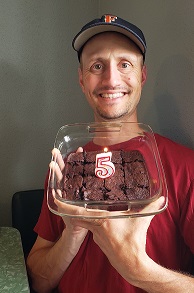When I started doing this blog five years ago the purpose of it was to highlight my career, my skills in interpretation, in education, in social media, and in creating a positive impression of me in the internet world.
 |
| mmmmm ... Halloween candy.... |
Essentially, it was to help me get jobs by being an ongoing piece of resume candy for potential employers to examine while attempting to fill what I considered a noticeable void in historical interpretation blog and web presence.
I think this has worked for me.
This last August I interviewed for a permanent interpretive position at a National Park and I was selected.
Naturally I am elated and the last two months since that time had been spent in preparation and retooling for this park. I am glad and proud to be part of their team and am applying myself. I would like to call my blog a mission success!
The question now remains as to what to do about my blog: should I keep writing or should I hang up my hat? Or should I do something else like slow my involvement to a quarterly submission or every other month?
While I ponder these thoughts, I welcome yours; write a comment here, or drop me an email or comment on my LinkedIn or Facebook posts. I read them. I really do.
Meanwhile, rather than rest on my laurels of finally achieving a degree of comfort and the joy of not having to move every six months, I still need to keep my job.
Here is my method for getting into a newfound position:
- Become a great employee before a great interpreter
- Make priority lists
- Content mastery comes with time
- Be part of the team
 |
| Cute Puppy Ellie |
1. When joining a new site, the first few days will be puppy-dogging around the place. By puppy-dogging, I mean that you get shown around to every place and meet everyone while following your guide like a puppy dog. Dogs are great; they are interested in everything you do with them even if they are not sure why it is important to you. Same thing for your first few days on the job. After that, subconsciously, your supervisors and coworkers begin to have more expectations of you, increasing every day from then on. The most important thing to do is to learn the daily operations of the place.
What is the procedure for this? Where is the key for that? Who answers the phone and how do you do it? Learning to be a worker and employee helps take the burden off of your coworkers doing the mundane or menial tasks that every job is heir to. Cementing procedure and routine is essential to learning the work rhythm.
 |
| ...and who does not really love a good list? |
2. Make priority lists. My experience has been to make lists and check them off as you get done so nothing gets overlooked. Few things are more upsetting than missing some crucial time sensitive task because your attention was on something else. Some of these have financial consequences, not just at work but on life tasks like getting licences or updating addresses. The list makes sure that you are aware of all of your obligations and necessary tasks, and they are hopefully arranged in such a way as to make sure they are completed in a timely manner before time sensitive tasks expire.
3. The daily operations and routines are the most important things to pick up. Everything else in terms of content can be picked up at a run. Each site is different and you will find what information is important quickly.
In my example, I worked at a location that did school programs all day long five days a week for a month solid, and with diminishing frequency up to three weeks after. My first day on school tours I observed two tours, by the third I did a co-tour with an experienced interpreter, and by the fourth tour, I was giving the tour on my own. Sometimes you get thrown in the fire.
Did I have all the answers or understand everything? No, of course not, but with repetition comes confident routine and only through time, talking with other interpreters, and finally research, can you start to get the whole picture. Spring and summer are the times to perform, and fall and winter are the slow seasons where content mastery comes. This might be nonexistent for the seasonal who is only there for a limited time, but gaining the additional content helps round out the programming and gives one the ability to answer the hard questions, as well as be able to make variations and even whole new programs!
 |
| Teamwork comes in all forms for all sorts of purposes |
4. Teamwork. Especially important when joining a team is making sure you are part of the team. Go out on a limb for them. Be a little vulnerable for them. Sure coworkers can be prickly or jaded or grumpy. You do not have to be super-friends with them, but they will appreciate the work you do for and with them with time and trust. Of course there are those coworkers who use people and manipulate them, but learning who to be guarded or open with starts with making that initial offer. Besides, your coworkers have probably been doing this a while and you will need their guidance.
There are probably a few other things that could be added to that list, but for now, those are the ones that have guided me over the last month.
In the meanwhile, I will be gaining content mastery. Ye, the reading audience, can suggest what I should do with the blog, so look forward to next month's post.







































